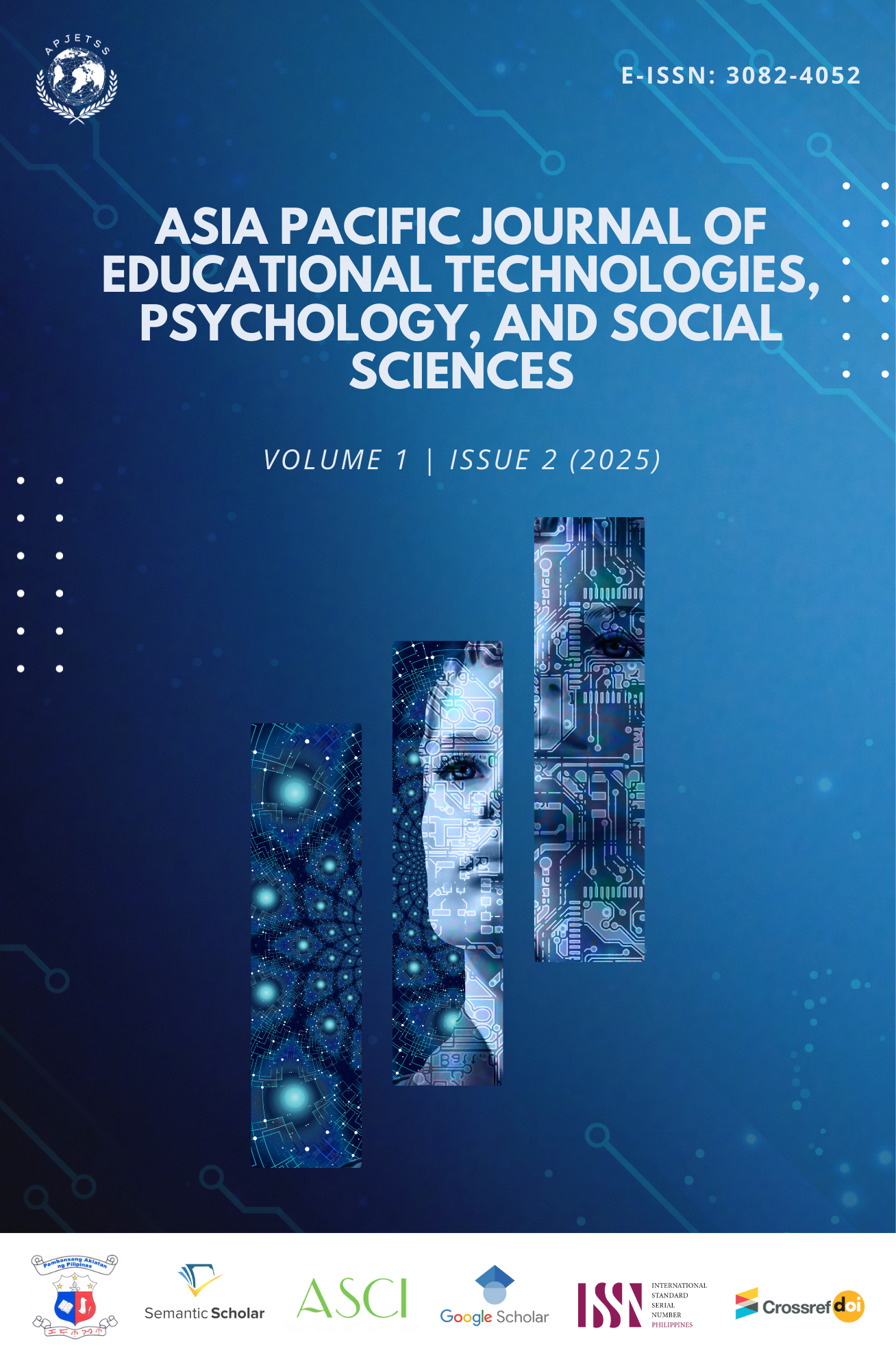Environmental Knowledge As A Predictor Of Science-Related Attitudes Among Senior High School Students
Main Article Content
Abstract
This study examined the influence of environmental knowledge on the science-related attitude among Senior High School (SHS) students. Anchored on Theory of Planned Behavior and Expectancy-Value Theory, a quantitative descriptive-correlational design was employed. A total of 70 SHS students participated in the study, selected through stratified random sampling. Two validated instruments assessed the levels of environmental knowledge and science-related attitudes. Pearson r indicated a significant positive relationship between environmental knowledge and SRA. Regression analysis showed 28.90% of the variance in EK can be explained by SRA. A single regression model was generated, confirming that environmental knowledge substantially influenced science-related attitude. The findings underscore the importance of promoting environmental knowledge to improve science-related attitude.
Article Details

This work is licensed under a Creative Commons Attribution 4.0 International License.
Copyright © 2024 APJETPS, its licensors, and contributors. All rights are reserved. For all open access content, the Creative Commons (CC) Attribution 4.0 International Public License terms apply.
References
Ardoin, N. M., Bowers, A. W., & Gaillard, E. (2020). Environmental education outcomes for conservation: A systematic review. Biological Conservation, 241, 108224. https://doi.org/10.1016/j.biocon.2019.108224
Arikunto, S. (2007). Prosedur penelitian: Suatu pendekatan praktik (Revised ed.). Rineka Cipta.
Blanchard, M. R., Southerland, S. A., Osborne, J. W., Sampson, V. D., Annetta, L. A., & Granger, E. M. (2010). Is inquiry possible in light of accountability? A quantitative comparison of the relative effectiveness of guided inquiry and verification laboratory instruction. Science Education, 94(4), 577–616. https://doi.org/10.1002/sce.20390
Böyük, U., & Kaya, H. (2011). Attitudes towards physics lessons and physical experiments of the high school students. European Journal of Physics Education, 2(1), 23–31. Retrieved from https://www.researchgate.net/publication/266031238
Chung, S., & Kim, H. (2021). Students’ perceptions of science and its relevance to everyday life: A qualitative case study. Science Education International, 32(2), 120–131. https://doi.org/10.33828/sei.v32.i2.4
Creswell, J. W. (2012). Educational research: Planning, conducting, and evaluating quantitative and qualitative research (4th ed.). Pearson Education.
Creswell, J. W., & Creswell, J. D. (2017). Research design: Qualitative, quantitative, and mixed methods approaches (5th ed.). SAGE Publications.
Eccles, J. S., Adler, T. F., Futterman, R., Goff, S. B., Kaczala, C. M., Meece, J. L., & Midgley, C. (1983). Expectancies, values, and academic behaviors. In J. T. Spence (Ed.), Achievement and achievement motives: Psychological and sociological approaches (pp. 75–146). W.H. Freeman.
Elfil, M., & Negida, A. (2017). Stratified randomization: A practical guide for clinical researchers. European Journal of Clinical Investigation, 47(1), 6–12. https://doi.org/10.1111/eci.12601
Fraser, B. J. (1981). TOSRA: Test of Science-Related Attitudes: Handbook. Australian Council for Educational Research.
Froiland, J. M., & Worrell, F. C. (2016). Intrinsic motivation, learning goals, engagement, and achievement in a diverse high school. Psychology in the Schools, 53(3), 321–336. https://doi.org/10.1002/pits.21901
Kahveci, H. (2023). The positive and negative effects of teacher attitudes and behaviors on student progress. Journal of Pedagogical Research, 7(1), 50–64. https://www.researchgate.net/publication/369327777
Kara, Y., Kahraman, S., & Ayas, A. (2020). The effect of environmental education on students’ environmental knowledge and science attitudes. International Electronic Journal of Environmental Education, 10(1), 15–29.
Kish, L. (1965). Survey sampling. John Wiley & Sons.
Olson, J. R., & Morrison, T. G. (2021). The role of environmental education in improving science attitudes among adolescents. Environmental Education Research, 27(5), 685–702.
Osborne, J., Simon, S., & Collins, S. (2003). Attitudes towards science: A review of the literature and its implications. International Journal of Science Education, 25(9), 1049–1079. https://doi.org/10.1080/0950069032000032199
Panacek, E. A., & Thompson, C. B. (2007). Sampling methods: Selecting your subjects. Air Medical Journal, 26(2), 75–78. https://doi.org/10.1016/j.amj.2007.01.001
Pe’er, S., Goldman, D., & Yavetz, B. (2007). Environmental literacy in teacher training: Attitudes, knowledge, and environmental behavior of beginning students. The Journal of Environmental Education, 39(1), 45–59. https://doi.org/10.3200/JOEE.39.1.45-59
Rosta Harun, Lim Kuang Hock, & Fadhilah Othman. (2011). Environmental knowledge and attitude among students in Sabah. World Applied Sciences Journal, 14(11), 83–87.
Sapungan, G. M., & Sapungan, R. M. (2014). Parental involvement in child’s education: Importance, barriers and benefits. Asian Journal of Management Sciences & Education, 3(2), 42–48. https://www.ajmse.leena-luna.co.jp
Tuan, H.-L., Chin, C.-C., & Shieh, S.-H. (2005). Students’ motivation toward science learning: A study of classroom instructional strategies. International Journal of Science Education, 27(6), 639–654. https://doi.org/10.1080/0950069042000323737
UNESCO. (2020). Education for sustainable development: A roadmap. United Nations Educational, Scientific and Cultural Organization. https://unesdoc.unesco.org/ark:/48223/pf0000374802
Yaman, S., Dönmez, C., & Yaman, H. (2019). Science literacy and the attitudes toward science: A structural equation modeling approach. Science Education International, 30(4), 279–285. https://doi.org/10.33828/sei.v30.i4.3

